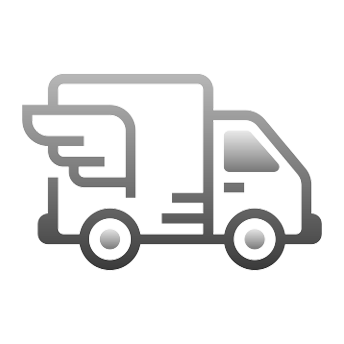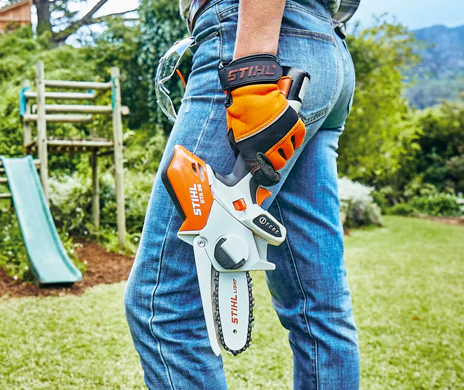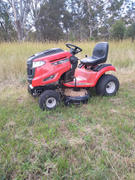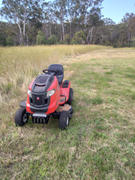Save $550
Rover Lawn King 18/42 Ride-On Lawn Mower
SKU: 13BGA1KS333
Low Doc Finance Available. Calculate Your Repayments Here.
Interest FREE Up to 36 Months*
Select Humm90 at Checkout
Glide over your lawn effortlessly and leave behind pristine, perfectly trimmed grass. This Rover Lawn King 18/42 model by Rover is a powerful, highly efficient ride-on lawnmower designed to erase the hassle and stress that mowing was once known for. Start up the engine and sit comfortably atop your lawn mower, and enjoy a more leisurely approach to household chores.
The high back seat includes arm rests, and places less stress on your back, an essential feature for those with bigger yards. Featuring a foot-operated transmission with cruise control, the Lawn King is ideal for larger outdoor areas and small acreages. The large 107cm (42") cutting deck is built with highly durable materials that can withstand rigorous use again and again.
This heavy-duty ride-on mower features a powerful 18 horsepower Kawasaki engine, able to handle long-term use with ease. Best of all, the Rover Lawn King is backed by Rover's famous 5+5 year engine and unit warranty, for year after year durability.
- Reviews
- Questions
Rover 18/42 Ride on mower
Great,cuts very well.The staffs at GYC are very helpful.They already set the mower up when it's delivered.I just need to turn the key on and off I go ,cutting the grass .Delivery time was very fast.Very happy customer.Thanks GYC.....
Great success
Love my new ride on. I have six acres of uneven land and the Lawn King does a beautiful job, has power to burn and is quick & easy to start. Lots of extras, plus it was a great price. Many thanks to the staff at Castle Hill for their time and expertise. :)
Rover Lawn King
So far so good, just one small thing, when I inspected the mower after delivery I noticed a dent in the right side of the bonnet, apart from that all seems to be fine, Regards Wal
Great product great price
So easy to use - starts perfectly and a dream to drive.

Price Match Guarantee
If you find a lower price on the Rover Lawn King 18/42 Ride-On Lawn Mower we will match it.

Free Assembly & Premium Handover
We’ll unbox, assemble and tune most garden power equipment orders, plus show you how everything works.*

Extra Savings with Click n Collect
Simply choose to pickup your Rover Lawn King 18/42 Ride-On Lawn Mower at one of our five Sydney stores to unlock extra discounts.*

Fast & Free Delivery Across Sydney
We dispatch orders fast and offer free shipping on orders over $1,000 to Sydney metro addresses.*


Buy Now, Pay Later Up to $1,000
Choose Zip Pay at checkout for up to $1,000 interest-free and make repayments weekly, fortnightly or monthly.*


Interest-Free Finance Up to $30,000
Choose Zip Money at checkout for up to $30,000 and up to 60 months interest free for those bigger buys.*
| Engine | |
|---|---|
Brand The manufacturer of the engine, influencing reliability, power, and availability of spare parts.
|
|
Model The specific engine series, indicating design, intended usage, and compatibility with different mower types. Some series are built for residential use, while others are suited for commercial applications.
|
|
Engine Type The configuration of the engine, such as single-cylinder for fuel efficiency or V-Twin for smoother operation and more power.
|
|
Power Output Measured in horsepower (HP), this determines how effectively the mower can handle thick grass, slopes, and demanding mowing conditions.
|
|
Displacement The engine size, measured in cubic centimeters (cc), influences power, fuel efficiency, and performance. Larger displacement engines typically offer more torque for challenging terrain.
|
|
Fuel Type The type of fuel the engine uses: Petrol (common for residential models), Diesel (better for commercial use), or Electric (eco-friendly and low maintenance).
|
|
Fuel Tank Capacity The amount of fuel the mower can hold, affecting how long it can run before needing a refill. Larger tanks are beneficial for covering large areas without interruptions.
|
|
Fuel Delivery Determines how fuel is supplied to the engine. Carbureted engines are simpler and easier to maintain, while fuel-injected engines offer better fuel efficiency and smoother operation.
|
|
Starting System The method used to start the engine. Common types include key start, push-button start, and manual pull start. Electric starters offer greater convenience.
|
|
Lubrication The system that keeps engine parts moving smoothly and reduces wear. Some engines use splash lubrication, while others use pressurized lubrication for better oil distribution.
|
|
Air Filtration System The filter type that prevents dirt and debris from entering the engine. Cyclonic or dual-stage filters offer better protection for dusty environments.
|
|
| Drive System | |
Transmission Type Dictates how power is transferred from the engine to the wheels. Options include manual, automatic, and hydrostatic transmissions, with hydrostatic being the smoothest and easiest to control.
|
|
Drive System Controls how the mower moves: Rear-wheel drive for good traction, all-wheel drive for challenging terrain, or four-wheel drive for maximum grip on slopes.
|
|
Forward Speed The maximum speed the mower can travel forward. Faster speeds allow for quicker mowing, but control and terrain should be considered.
|
|
Reverse Speed The top speed when moving in reverse. A higher reverse speed improves maneuverability, especially in tight spaces.
|
|
Drive Control The steering and movement system. Common types include pedal-operated hydrostatic control, lap bars for zero-turn mowers, and manual gear shifting.
|
|
Cruise Control A feature that maintains a consistent speed without holding down the accelerator, reducing fatigue on large properties.
|
|
Differential Lock A feature that locks the rear wheels together for better traction on uneven or slippery terrain.
|
|
| Cutting System | |
Cutting Width The total width of grass cut in a single pass. A wider cutting width reduces mowing time but requires more open space to maneuver.
|
|
Block Size Recommended Block size that this Mower is best suited for, providing optimal performance and efficiency.
|
|
Number of Blades More blades generally provide a finer cut and better grass dispersion. Mowers with multiple blades cover more ground efficiently.
|
|
Cutting Deck Construction Refers to the material and design of the mower deck. Fabricated steel decks are more durable than stamped steel and provide better resistance to impacts.
|
|
Cutting Deck Thickness Refers to the gauge or thickness of the steel used in the mower's cutting deck. A thicker deck (lower gauge number) provides greater durability, resistance to impacts, and longer lifespan, making it ideal for heavy-duty use.
|
|
Cutting Height Range The range of heights at which the mower can cut grass. Adjustable cutting heights allow for different lawn types and seasonal mowing needs.
|
|
Cutting Height Adjustment The method for adjusting height: Manual lever, foot-operated, or electric for easier precision.
|
|
Blade Engagement The mechanism used to activate the blades. Manual engagement requires a lever, while electric PTO (Power Take-Off) engagement allows for smoother operation with the push of a button.
|
|
Deck Lift System The method used to raise or lower the cutting deck. Some mowers use manual levers, while others offer foot-operated or electric deck adjustments for ease of use.
|
|
Anti-Scalp Wheels Small wheels attached to the deck to prevent scalping on uneven ground.
|
|
Side Discharge Expels grass clippings out the side of the mower for quick disposal.
|
|
Rear Discharge Expels clippings behind the mower, useful for commercial or municipal applications.
|
|
Mulching Capability Allows the mower to finely chop grass clippings and return them to the lawn as natural fertilizer, reducing the need for bagging.
|
|
Bagging System Compatibility Indicates whether a grass catcher can be attached to collect clippings for disposal or composting.
|
|
| Steering & Handling | |
Steering Type Defines how the mower is maneuvered. Options include traditional steering wheels, lap bars for zero-turn models, and joystick controls for advanced handling.
|
|
Turning Radius The amount of space needed for a complete turn. A zero-turn mower can rotate 360° in place, making it ideal for navigating around obstacles.
|
|
Maximum Slope Capability Refers to steepest incline a mower can safely operate on while maintaining stability and traction. Measured in degrees this factor is crucial for hilly or uneven terrain. Operating a mower beyond its slope capacity can lead to loss of control or rollover.
|
|
Suspension Whether the mower has shock-absorbing suspension, improving comfort on rough terrain.
|
|
Front Tires Affect steering responsiveness and stability. Larger front tires improve maneuverability, while textured tread patterns provide better traction.
|
|
Rear Tires Play a key role in traction and support. Larger rear tires improve grip, reduce turf damage, and provide better stability on slopes.
|
|
| Comfort & Convenience | |
Seat Type Determines operator comfort during long mowing sessions. High-back and cushioned seats provide more support than basic seats.
|
|
Seat Adjustment The ability to adjust the seat position for comfort and better control. Some mowers offer tool-free adjustments, while others require manual adjustment.
|
|
Armrests Armrests provide extra comfort for long mowing hours.
|
|
Cup Holder A small but handy feature for holding drinks while mowing.
|
|
USB Charging Port Allows charging of mobile devices while operating the mower.
|
|
Deck Height Adjustment How the cutting height is changed. Some mowers use a simple lever, while others offer foot-operated or electric adjustments for greater ease.
|
|
Headlights Helps improve visibility in low-light conditions.
|
|
Hour Meter Tracks total engine runtime, useful for maintenance scheduling.
|
|
Bluetooth Connectivity Some mowers offer app connectivity for maintenance tracking and performance monitoring.
|
|
| Build & Durability | |
Frame Construction The strength and material of the mower’s main body. Welded steel frames offer greater durability compared to bolted frames.
|
|
Corrosion Protection Special coatings or materials used to prevent rust and extend the lifespan of the mower, particularly in humid or wet conditions.
|
|
Bumper Protection A front bumper or brush guard protects the mower from damage.
|
|
Warranty The manufacturer’s warranty period, which may vary for different parts of the mower.
|
|
Country of Manufacture Indicates where the product is designed and built.
|
|
| Safety Features | |
Rollover Protection System A protective bar that reduces rollover risks, commonly found on commercial mowers.
|
|
Seat Safety Switch A feature that automatically shuts off the engine if the operator leaves the seat.
|
|
Reverse Mowing Safety Prevents the blades from cutting while the mower is in reverse, unless overridden.
|
|
Parking Brake Locks the mower in place when parked, preventing unintended movement on slopes or uneven terrain.
|
|
Operator Presence System A safety feature that shuts off the engine or blades if the operator leaves the seat, preventing accidents.
|
|
| Dimensions & Weight | |
Weight The total weight of the mower, which affects stability, handling, and transport. Heavier mowers provide more traction but may require a trailer for transport.
|
|
Overall Dimensions The mower’s full size, helping determine if it fits in a shed or trailer.
|
|
| Additional Features | |
Tow Hitch Allows the mower to pull carts, spreaders, aerators, and trailers.
|
|
Attachments Available Additional tools that enhance mower functionality.
|
|
Smart Technology Some high-end mowers include smart features for remote tracking and performance monitoring.
|
|
| Engine | |||
|---|---|---|---|
Brand The manufacturer of the engine, influencing reliability, power, and availability of spare parts.
|
|
|
|
Model The specific engine series, indicating design, intended usage, and compatibility with different mower types. Some series are built for residential use, while others are suited for commercial applications.
|
|
|
|
Engine Type The configuration of the engine, such as single-cylinder for fuel efficiency or V-Twin for smoother operation and more power.
|
|
|
|
Power Output Measured in horsepower (HP), this determines how effectively the mower can handle thick grass, slopes, and demanding mowing conditions.
|
|
|
|
Displacement The engine size, measured in cubic centimeters (cc), influences power, fuel efficiency, and performance. Larger displacement engines typically offer more torque for challenging terrain.
|
|
|
|
Fuel Type The type of fuel the engine uses: Petrol (common for residential models), Diesel (better for commercial use), or Electric (eco-friendly and low maintenance).
|
|
|
|
Fuel Tank Capacity The amount of fuel the mower can hold, affecting how long it can run before needing a refill. Larger tanks are beneficial for covering large areas without interruptions.
|
|
|
|
Fuel Delivery Determines how fuel is supplied to the engine. Carbureted engines are simpler and easier to maintain, while fuel-injected engines offer better fuel efficiency and smoother operation.
|
|
|
|
Starting System The method used to start the engine. Common types include key start, push-button start, and manual pull start. Electric starters offer greater convenience.
|
|
|
|
Lubrication The system that keeps engine parts moving smoothly and reduces wear. Some engines use splash lubrication, while others use pressurized lubrication for better oil distribution.
|
|
|
|
Air Filtration System The filter type that prevents dirt and debris from entering the engine. Cyclonic or dual-stage filters offer better protection for dusty environments.
|
|
|
|
| Drive System | |||
Transmission Type Dictates how power is transferred from the engine to the wheels. Options include manual, automatic, and hydrostatic transmissions, with hydrostatic being the smoothest and easiest to control.
|
|
|
|
Drive System Controls how the mower moves: Rear-wheel drive for good traction, all-wheel drive for challenging terrain, or four-wheel drive for maximum grip on slopes.
|
|
|
|
Forward Speed The maximum speed the mower can travel forward. Faster speeds allow for quicker mowing, but control and terrain should be considered.
|
|
|
|
Reverse Speed The top speed when moving in reverse. A higher reverse speed improves maneuverability, especially in tight spaces.
|
|
|
|
Drive Control The steering and movement system. Common types include pedal-operated hydrostatic control, lap bars for zero-turn mowers, and manual gear shifting.
|
|
|
|
Cruise Control A feature that maintains a consistent speed without holding down the accelerator, reducing fatigue on large properties.
|
|
|
|
Differential Lock A feature that locks the rear wheels together for better traction on uneven or slippery terrain.
|
|
|
|
| Cutting System | |||
Cutting Width The total width of grass cut in a single pass. A wider cutting width reduces mowing time but requires more open space to maneuver.
|
|
|
|
Block Size Recommended Block size that this Mower is best suited for, providing optimal performance and efficiency.
|
|
|
|
Number of Blades More blades generally provide a finer cut and better grass dispersion. Mowers with multiple blades cover more ground efficiently.
|
|
|
|
Cutting Deck Construction Refers to the material and design of the mower deck. Fabricated steel decks are more durable than stamped steel and provide better resistance to impacts.
|
|
|
|
Cutting Deck Thickness Refers to the gauge or thickness of the steel used in the mower's cutting deck. A thicker deck (lower gauge number) provides greater durability, resistance to impacts, and longer lifespan, making it ideal for heavy-duty use.
|
|
|
—
|
Cutting Height Range The range of heights at which the mower can cut grass. Adjustable cutting heights allow for different lawn types and seasonal mowing needs.
|
|
|
|
Cutting Height Adjustment The method for adjusting height: Manual lever, foot-operated, or electric for easier precision.
|
|
|
|
Blade Engagement The mechanism used to activate the blades. Manual engagement requires a lever, while electric PTO (Power Take-Off) engagement allows for smoother operation with the push of a button.
|
|
|
|
Deck Lift System The method used to raise or lower the cutting deck. Some mowers use manual levers, while others offer foot-operated or electric deck adjustments for ease of use.
|
|
|
|
Anti-Scalp Wheels Small wheels attached to the deck to prevent scalping on uneven ground.
|
|
|
|
Side Discharge Expels grass clippings out the side of the mower for quick disposal.
|
|
|
|
Rear Discharge Expels clippings behind the mower, useful for commercial or municipal applications.
|
|
|
|
Mulching Capability Allows the mower to finely chop grass clippings and return them to the lawn as natural fertilizer, reducing the need for bagging.
|
|
|
|
Bagging System Compatibility Indicates whether a grass catcher can be attached to collect clippings for disposal or composting.
|
|
|
|
| Steering & Handling | |||
Steering Type Defines how the mower is maneuvered. Options include traditional steering wheels, lap bars for zero-turn models, and joystick controls for advanced handling.
|
|
|
|
Turning Radius The amount of space needed for a complete turn. A zero-turn mower can rotate 360° in place, making it ideal for navigating around obstacles.
|
|
|
|
Maximum Slope Capability Refers to steepest incline a mower can safely operate on while maintaining stability and traction. Measured in degrees this factor is crucial for hilly or uneven terrain. Operating a mower beyond its slope capacity can lead to loss of control or rollover.
|
|
|
|
Suspension Whether the mower has shock-absorbing suspension, improving comfort on rough terrain.
|
|
|
|
Front Tires Affect steering responsiveness and stability. Larger front tires improve maneuverability, while textured tread patterns provide better traction.
|
|
|
|
Rear Tires Play a key role in traction and support. Larger rear tires improve grip, reduce turf damage, and provide better stability on slopes.
|
|
|
|
| Comfort & Convenience | |||
Seat Type Determines operator comfort during long mowing sessions. High-back and cushioned seats provide more support than basic seats.
|
|
|
|
Seat Adjustment The ability to adjust the seat position for comfort and better control. Some mowers offer tool-free adjustments, while others require manual adjustment.
|
|
|
|
Armrests Armrests provide extra comfort for long mowing hours.
|
|
|
|
Cup Holder A small but handy feature for holding drinks while mowing.
|
|
|
|
USB Charging Port Allows charging of mobile devices while operating the mower.
|
|
|
|
Deck Height Adjustment How the cutting height is changed. Some mowers use a simple lever, while others offer foot-operated or electric adjustments for greater ease.
|
|
|
|
Headlights Helps improve visibility in low-light conditions.
|
|
|
|
Hour Meter Tracks total engine runtime, useful for maintenance scheduling.
|
|
|
|
Bluetooth Connectivity Some mowers offer app connectivity for maintenance tracking and performance monitoring.
|
|
|
|
| Build & Durability | |||
Frame Construction The strength and material of the mower’s main body. Welded steel frames offer greater durability compared to bolted frames.
|
|
|
|
Corrosion Protection Special coatings or materials used to prevent rust and extend the lifespan of the mower, particularly in humid or wet conditions.
|
|
|
|
Bumper Protection A front bumper or brush guard protects the mower from damage.
|
|
|
|
Warranty The manufacturer’s warranty period, which may vary for different parts of the mower.
|
|
|
|
Country of Manufacture Indicates where the product is designed and built.
|
|
|
|
| Safety Features | |||
Rollover Protection System A protective bar that reduces rollover risks, commonly found on commercial mowers.
|
|
|
|
Seat Safety Switch A feature that automatically shuts off the engine if the operator leaves the seat.
|
|
|
|
Reverse Mowing Safety Prevents the blades from cutting while the mower is in reverse, unless overridden.
|
|
|
|
Parking Brake Locks the mower in place when parked, preventing unintended movement on slopes or uneven terrain.
|
|
|
|
Operator Presence System A safety feature that shuts off the engine or blades if the operator leaves the seat, preventing accidents.
|
|
|
|
| Dimensions & Weight | |||
Weight The total weight of the mower, which affects stability, handling, and transport. Heavier mowers provide more traction but may require a trailer for transport.
|
|
|
|
Overall Dimensions The mower’s full size, helping determine if it fits in a shed or trailer.
|
|
|
|
| Additional Features | |||
Tow Hitch Allows the mower to pull carts, spreaders, aerators, and trailers.
|
|
|
|
Attachments Available Additional tools that enhance mower functionality.
|
|
|
|
Smart Technology Some high-end mowers include smart features for remote tracking and performance monitoring.
|
|
|
|









































 Fast & Convenient Delivery
Fast & Convenient Delivery












